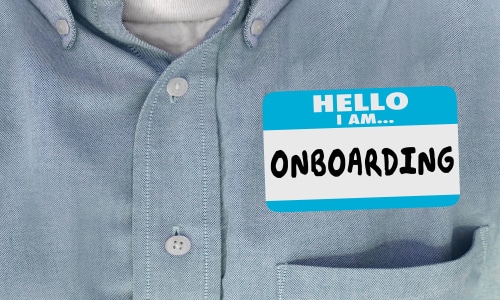Employee Onboarding – Creating a Lasting Relationship with Your Newest Team Member

Will it be a long-term love affair, or will it fizzle within a few weeks or years? When talking about employees, companies should place heavy stock in properly onboarding employees from the moment they begin the hiring process until well after an employee has begun working in their new position.
As with any relationship, building a solid foundation is critical and can be costly if the relationship goes south. Did you know employee turnover can cost a company as much as 33% of an employee’s annual salary?
According to Employee Benefits News in 2017, if an employee earns $45,000/year, the company will spend $15,000 in addition to the annual salary on items like recruiting and interview costs. Additional, and possibly less obvious, costs include loss of productivity as other employees pick up the slack and the time it takes a new employee to get up to speed.
So, with the cost of turnover weighing heavy on your mind, it’s time to focus on building a strong bond with your new team member. This is done through organizational socialization, otherwise known as onboarding. And, this is not as easy as it sounds.
According to experts at the Society for Human Resource Management (SHRM):
“Onboarding new hires at an organization should be a strategic process that lasts at least one year…because how employers handle the first few days and months of a new employee’s experience is crucial to ensuring high retention.”
How Your Organization Can Make a Great First Impression
Through conversations with friends and colleagues, I have learned that the company’s first impression is a lasting one. This means, if the recruiter doesn’t respond promptly to inquiries or potential candidates’ questions, these candidates can start off their relationship with your company on shaky ground. That said, it’s important to realize your company is being interviewed, too. Don’t lose sight of your company’s image as you seek to find your perfect fit.
Once you’ve made a good first impression, it’s critical to keep it going. Consider how you might feel as a new employee walking into your first day on the job with these questions:
- Would you expect to see your office/desk setup and fully functional so that you can hit the ground running?
- Where are the restrooms and lunch/break room?
- What is the company dress code?
- Where should employees park their cars?
- What information is critical to know on your first day, i.e. who do you turn to for questions; what are your expected goals for your first day, week, month, and year?
How Can HR Tools Support Your Organization’s Onboarding?
With today’s abundant access to technology, many of these questions can be answered before a new employee starts their first day. At NFP Partners, we use an HR management software tool called, PurelyHR. This allows us to use their onboarding checklist where we can upload documents and assign onboarding tasks to team members.
This is a new tool for our team, but the advantages of utilizing HR software to assist with our HR needs are already apparent. For many small businesses, it can help move you away from tracking HR information in Word docs and Excel spreadsheets.
Onboarding Team Work
In order to successfully onboard a new employee, it’s important to involve your entire team. You’ll want to get buy-in from them regarding the importance of making new employees feel welcome and leading them in the right direction from day one. This can be accomplished by keeping them involved throughout the process.
Schedule welcome meetings, both as an organization and one-on-ones, to help the team get to know each other. If you work in a remote environment as we do, virtual, on-camera meetings are essential. Tools like Office Teams and Zoom can break the distance barrier. These tools can also support the team in putting a face to a name and help employees build a solid working foundation.

From First Day to First Year – An Onboarding Template For Your Nonprofit
Here’s a quick snapshot of what a new employee’s first year may look like with the team:
Day 1 –
- Welcome your new employee, introduce your organization’s objective, and set expectations
- Introduce team members and provide a clear account of your new team member’s role as well as the roles of existing team members
- Set a meeting between the new team member and their manager to answer any questions about the company and company culture
- Discuss learning styles of the employee and management style of the immediate supervisor
- Set the stage for a strong relationship with the manager/employee
- Discuss communication preferences, i.e. phone, video chat, email, text, etc.
- Commit to regular meetings, i.e. weekly, monthly, etc. (keep in mind this may change down the road)
- Set written performance goals and deadlines
First Few Weeks to Months –
- Schedule a meeting with the management team and the new employee at the end of the first week to answer any questions that may have come up
- Schedule regular check-ins at the end of each month (not just the first month) to assess your new employee’s comfort with their role and tools offered
- Take the time to recognize their immediate contributions to encourage them to continue and increase their engagement
- Discuss ideas for improvement and review performance goals
- Provide job-shadowing or mentorship opportunities
First Six Months to One Year –
- Continue regular touch-base meetings while exposing the employee to opportunities to engage with the team, and participate in community events and activities (both internal and external)
- Provide additional opportunities for building their knowledge-base and continued development
- Check-in on employee’s expectations of their role and how it aligns to the plan established earlier in the year
- Assess whether the employee’s skills and knowledge are being utilized fully
- Begin discussing the year ahead
Remember, your newest employee is not just a new person, they are a dynamic part of your already established team. Making them feel welcomed and engaged throughout the onboarding process will help facilitate a positive, long-term relationship.

